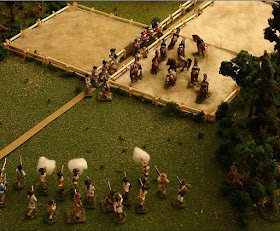As argued in a recent post, some skepticism is in order when assessing pension applications. The pension application of Absalom Baker is a case in point: He claimed to have been, in 1780, captured at Charleston, exchanged 30 days later, and than served at the battles of Waxhaws, Ramsour's Mill, Hanging Rock, Camden (where he was allegedly wounded), and King's Mountain. (Waxhaws, notably, was fought 2-and-a-half weeks after Charleston fell). However, friends vouched for Baker's presence at Charleston, Hanging Rock, Camden, and King's Mountain).
William McMurry, of the 6th South Carolina Regiment, claimed to have been a Continental from about 1779 to 1782, yet stated he fought at Rocky Mount, Hanging Rock, and Camden. No explanation was given for why he was not in captivity after Charleston fell.
Jesse Harrison, of the 10th (and later 1st) North Carolina Regiment, was one to provide some account of how he escaped captivity. He claimed to have served as a North Carolina Continental "untill the fall of Charleston, at which place he escaped, being taken out with the waggons." Subsequently he served at Hanging Rock and Camden.
James Courson, of the 6th South Carolina Regiment, stated that he “was at the siege of Charleston & was taken prisoner then. Most of my comrades were put on board prison ships but there were a great many of the prisoners inoculated on account of the small pox I having had the small pox in my childhood was removed for the purpose of nursing the sick from which place I escaped after about a month. I joined Sumpter the day after the battle of Rocky mount & the next Sunday after we fought the battle of the Hanging rock.”
Robert Wilson, of the 3rd South Carolina Regiment, claimed that he served "until the capture of Charleston in May 1780 when he was surrendered a prisoner of war with General Lincoln's Army – was under a limited parole, on Haddrell's Point near Charleston, a few days before his parole was out, he made his escape, and came home.” However, he didn't remain free for very long: “a few days after his Return was taken prisoner by a party of Tories." After escaping a second time, he "immediately joined General Sumpter upon Clem's Branch in the State of North Carolina, and served until the British left Charleston, That during his Service under General Sumter he was in the Battle at Rocky Mountain, & Hanging Rock.”
A statement by Captain James Jamieson in Wilson's application vouches for this history: “although this deponent never belonged to the Continental establishment himself, yet he has no doubt from many circumstances, that Robert Wilson was captured at Charleston, South Carolina, and made his escape from the British at Haddrell's point, where he was confined on parole, not to go beyond a certain limit: that this was in the month of June, a sickly season of the year, when his life would have been lost by remaining in so unhealthy a place: that said Wilson escaped by breaking his parole, and returning home to Chester District where he was taken prisoner by a gang of Tories from whom he again made his escape, and fled to general Sumter, whose Army said Wilson joined at Haggler's branch, where said Wilson and this deponent served together under Sumter, until this deponent was disabled from further service, by wounds received at the battle of 'Hanging Rock.'"

Sources:
Will Graves transcribed the pension application of Absalom Baker. (.pdf file).
Will Graves transcribed the pension application of William McMurry. (.pdf file).
Will Graves transcribed the pension application of Robert Wilson. (.pdf file).C. Leon Harris transcribed and annotated the pension application of James Courson. (.pdf file).
C. Leon Harris transcribed and annotated the pension application of Jesse Harrison. (.pdf file).














